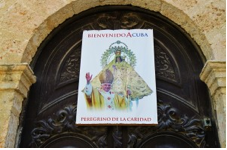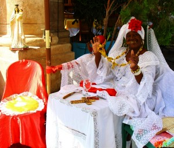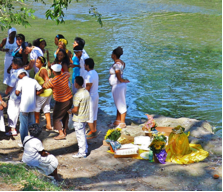
![]()
Index • |
Welcome • |
About
Us • |
21st Century • The Future |
World
Travel • Destinations |
Reviews • Books & Film |
Dreamscapes • Original Fiction |
Opinion
& Lifestyle • News Analysis now |
Film
Space • Movies in depth |
Kid's
Books • Reviews & stories |
Dreamscapes Two • More Original Fiction |
Lifestyles Archive • Politics & Living |
The International Writers Magazine: Cuba and Faith
• Olga Stavrakis
In a fortuitious coincidence the Pope happened to have arrived in Havana, Cuba on March 26, 2012, the day I was visiting with a group from the UK. Posters of the Pope’s visit were plastered all over the city.
Looking closely at the poster I was intrigued that there was no mention of the Virgin, the patroness of Cuba. And yet, she was prominently displayed behind and above the Pope’s image. On the bottom of the poster, were the words, “Peregrino de la Caridad,” literally translated as “Pilgrim of Charity,” a curious allusion to symbols I did not understand.
In the cathedral square a woman in white, a priestess of Santeria sat at a card table dispensing blessings. She had a small statue of the Virgin by her side. I asked the guide about it. “Oh yes, the statue represents Ochun. We worship her here in Cuba. She is the most important saint.”
Ochun (pronounced O-Shoon) is clearly not a Christian saint. Yet, everyone I asked about the image on the poster, identified the figure behind the Pope as either Ochun or La Caridad del Cobre. Nobody referred to her as the Virgin. Confused, I kept on asking people on the street and bit by bit the real story behind the Pope’s poster emerged.
Ochun is a Yoruba African goddess brought to the Caribbean, Brazil and the southern US by slaves. Since African religions were forbidden, the slaves merged their deities with Christian saints creating what is called “Santeria” or “saint worship.” Ochun, the mother goddess of all was merged with the Virgin Mary. But in the blend, both deities changed. La Caridad del Cobre, is the Christian patroness of Cuba. A figure no more than about a foot high, she was found in 1604, floating on the sea after a terrible storm off the town now called Cobre, by three men in a small boat. As the storm abated, they saw a small figure, no bigger than a doll standing on a piece of wood holding a child on her right arm and a cross in her left hand. She was completely dry and dressed in a beautiful yellow mantel over a white satin gown.
Today, she remains in Cobre and represents the tremendous depth of Cuban religious faith. She has been referred to in the literature, as the essence of “Cubanness” and Cubans translate the Spanish word “Caridad” not literally as “charity” but as “Love.” They do not refer to her as “The Virgin” but either as “La Caridad” or “Ochun.”
The words along the bottom of the Vatican’s poster -- “Peregrino de la Caridad,” translate into “Pilgrim of Love.” What that clearly says to Cubans is that the Pope comes as a pilgrim to pay homage to La Caridad. In other words, he seeks her blessing. In so doing, he is implicitely also paying homage to her as Ochun.
On Sunday, as we drove over a bridge, I noticed a group of people were drumming and dancing by the river bank below. Getting out, I watched a drummer playing African rhythms while the participants sang a repetitive and almost chant like song, dancing in a style I had seen in a Voodoo Village in West Africa. A yellow robe with white satin lace, was spread out on a large stone by the river and garlanded with yellow roses.
As I watched from a nearby rock, a local man standing next to me crossed himself.Ochun is the goddess mother of all humanity and merged with the Virgin, who is celebrated always as “la Caridad” or “Love.” She represents the love that is given freely by mother to child. She reminds Cubans of the pain of loss and the power of healing, something that gave solace to an enslaved and suffering population.
It is to the great credit of the Vatican that the Pope had chosen to pay homage to La Caridad as a pilgrim and by so doing, show his respect for the eternal love Cubans refer to as Ochun.www.travelwitholga.com
www.puleston.org© Olga Stavrakis July 2012
More travel



